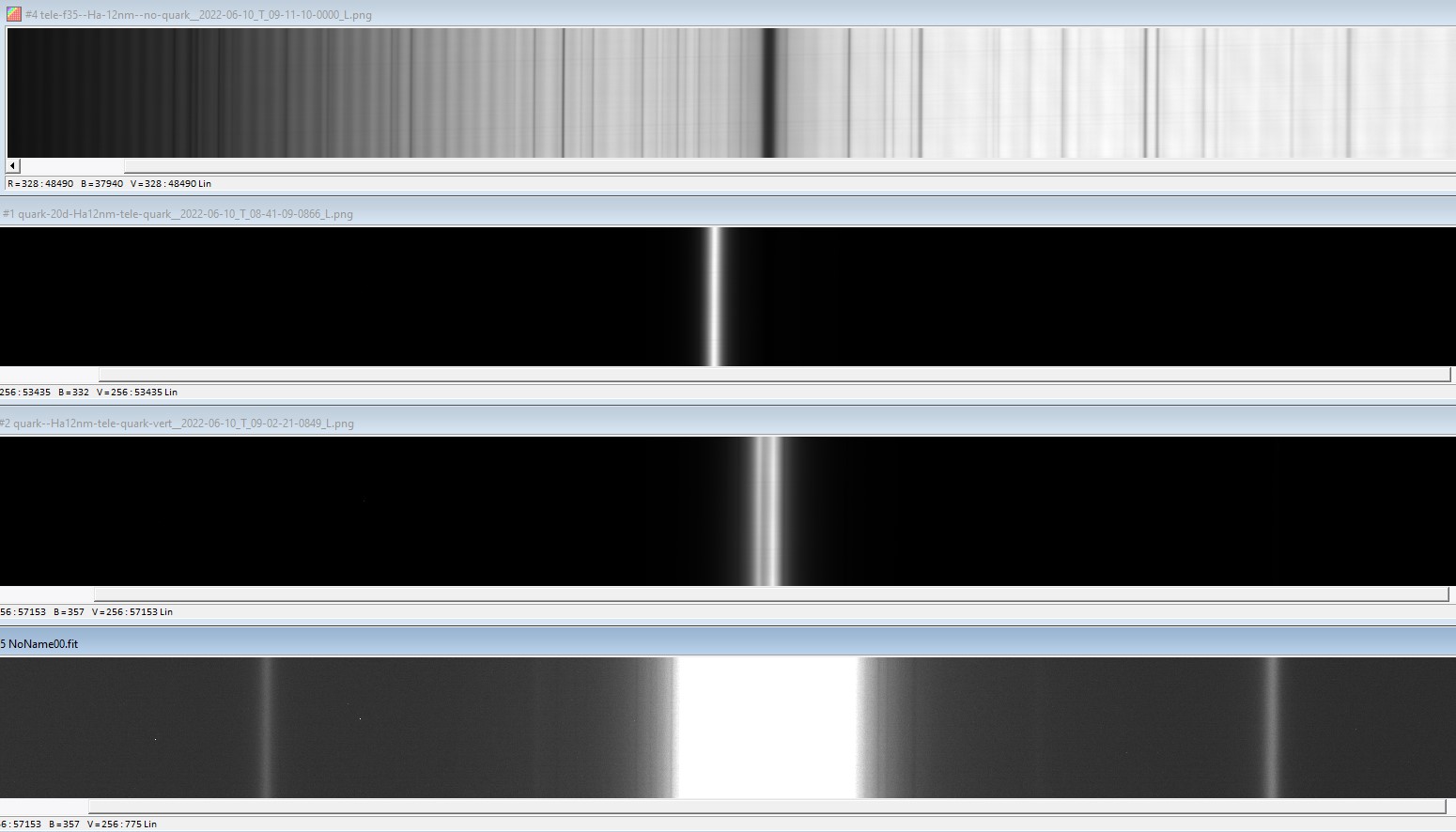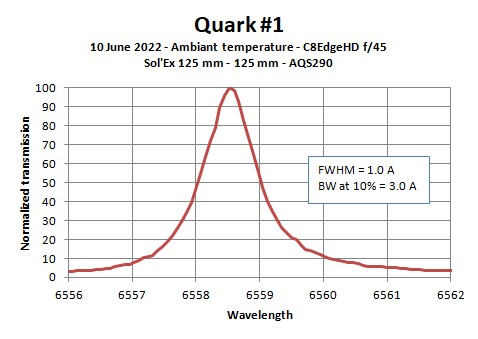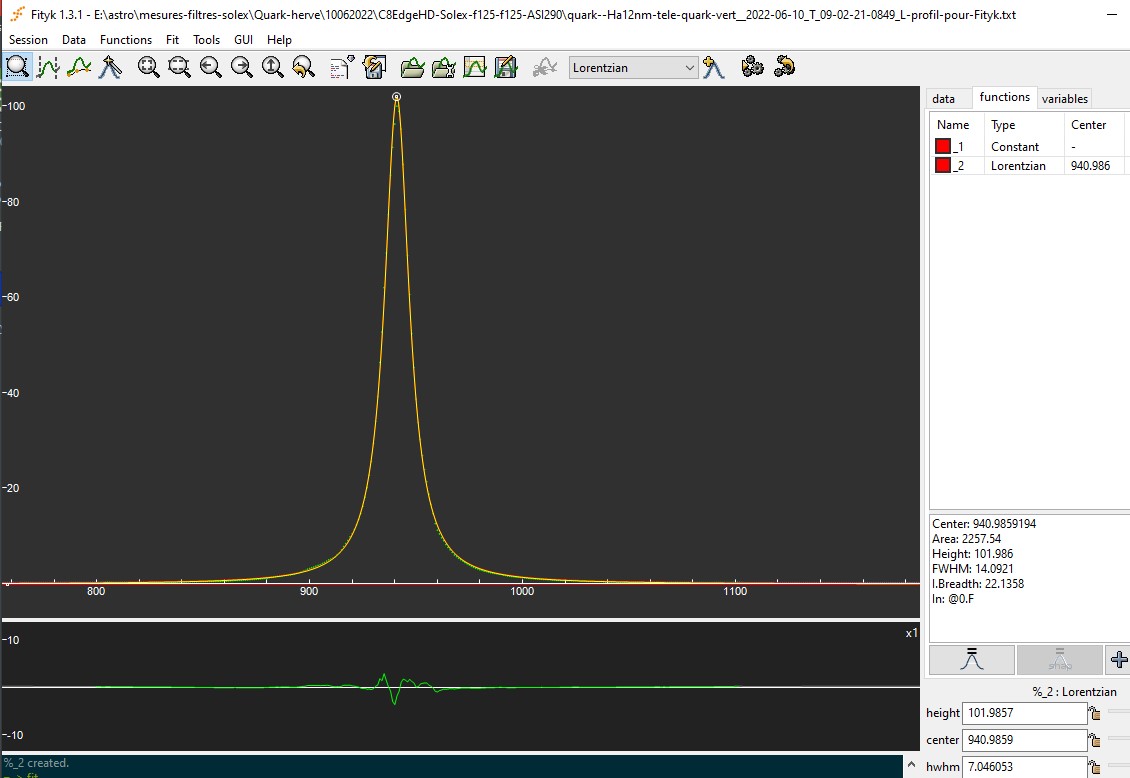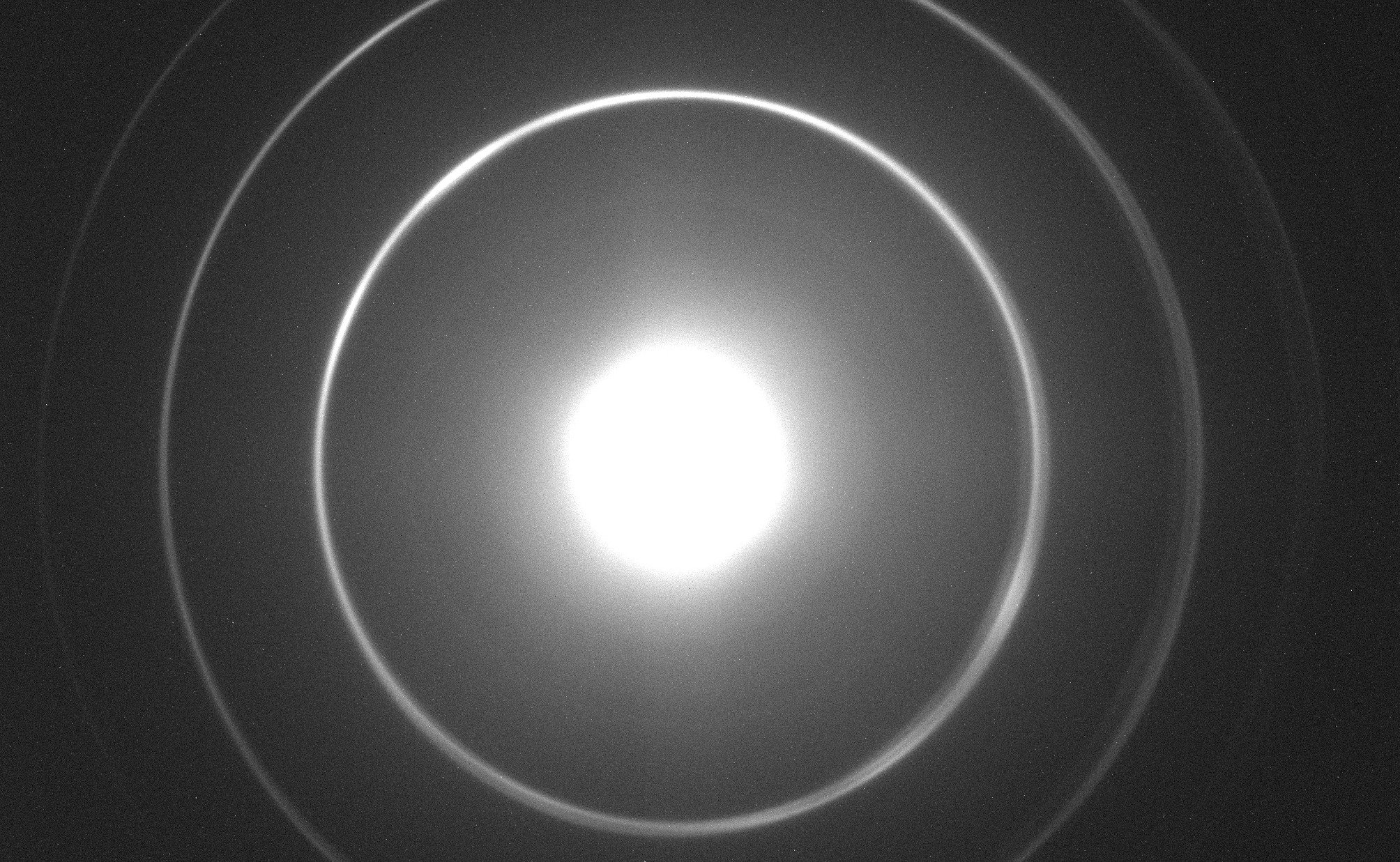(June 2022)
The filter was measured using the following approaches:
- Sol'Ex spectrometer in a f/45.1 telecentric beam (C8 EdgeHD f/10.5 => Quark with its 4.3× telecentric => Sol'Ex),
- Sol'Ex spectrometer in a f/31.4 telecentric beam (Takahashi TOA 150 f/7.3 => Quark with its 4.3× telecentric => Sol'Ex).
- Sol'Ex spectrometer in a f/45.1 telecentric beam (C8 EdgeHD f/10.5 => Quark with its 4.3× telecentric => Sol'Ex),
- Sol'Ex spectrometer in a f/31.4 telecentric beam (Takahashi TOA 150 f/7.3 => Quark with its 4.3× telecentric => Sol'Ex).
| Filter | Test method | f-ratio | Surface measured | FSR | FWHM | Bandwith at 10% peak transmission |
| Quark #1 | Ha lamp | collimated | Full aperture |
39.3 A |
||
| Quark #1 | Sol'Ex spectro (fc = 125 mm, fi = 125 mm, ASI290, 0.075 A/px dispersion) |
f/45.1 telecentric | 10 micron x 4.5 mm | 40.0 A |
1.0 A |
3.0 A |
| Quark #1 | Sol'Ex spectro (fc = 125 mm, fi = 125 mm, ASI290, 0.075 A/px dispersion) |
f/31.4 telecentric | 10 micron x 4.5 mm | 1.1 A | 3.0 A |
Sol'Ex spectrometer: measurement in a f/45 telecentric beam
Optical setup: Sun => Hat 8 telescope => Quark with its 4.3× telecentric beam => Astronomilk Ha 12 nm => Sol'Ex spectrograph
10 microns slit, 125 mm collimating lens, 125 mm imaging lens, ASI290 camera, 12-bit acquisition.
Measured dispersion = 0.0757 A/pixel
Conditions : deep blue sky
10 June 2022

Four succesive images :
- Solar spectrum.
- Solar spectrum transmitted by the Quark at ambiant temperature. This spectrum is registered to the solar spectrum.
- Solar spectrum transmitted by the Quark at regulated temperature and tuned at Ha (about 57°C).
- Same as before but with different vizualisation thresholds to show the secondary peaks of transmission of the etalon (for FSR measurement).
- Solar spectrum.
- Solar spectrum transmitted by the Quark at ambiant temperature. This spectrum is registered to the solar spectrum.
- Solar spectrum transmitted by the Quark at regulated temperature and tuned at Ha (about 57°C).
- Same as before but with different vizualisation thresholds to show the secondary peaks of transmission of the etalon (for FSR measurement).

The FSR is equal to 40.0 A.
The transmission profile of the etalon is given by the ratio "transmitted solar spectrum/solar spectrum". The profile was measured at different temperatures from ambiant to tuned to Ha. The results are the same to +/- 0.05 A.


The direct measurement on the graph at 50 % and 10% peak transmission are given on the graphs.
Curve fitting with a Lorentzian give FWHM values of 1.05 A and 0.95 A respectively.
Here is the example with the Quark tuned to Ha line. FWHM obstained by curve-fiiting with a Lorentzian function is equal to 14.1 pixel × 0.75 A/pixel = 1.05 A

Given the f-ratio of the telecentric beam (f/47), the measured value is identical to the nominal FWHM that would be measured in a collimated beam.
Curve fitting with a Lorentzian give FWHM values of 1.05 A and 0.95 A respectively.
Here is the example with the Quark tuned to Ha line. FWHM obstained by curve-fiiting with a Lorentzian function is equal to 14.1 pixel × 0.75 A/pixel = 1.05 A

Given the f-ratio of the telecentric beam (f/47), the measured value is identical to the nominal FWHM that would be measured in a collimated beam.
Sol'Ex spectrometer: measurement in a f/31.4 telecentric beam
Optical setup: Sun => Takahashi TOA 150 f/7.3 => Quark with its 4.3× telecentric beam => Sol'Ex spectrograph
10 microns slit, 125 mm collimating lens, 125 mm imaging lens, ASI290 camera, 12-bit acquisition.
Measured dispersion = 0.0757 A/pixel
4 June 2022

The measured FWHM (1.1 A) is consistent with the small FWHM broadening due to the lower f-ratio (f/31.4 instead of f/45.1)
Test in diffuse Ha light
Optical setup: Ha lamp => diffuser => Quark telecentric => Quark filter => Nikkor 50 mm f/1.8 S => Nikkor Z6

Nikon Z6 camera - 50 mm f/1.8 S at f/2 - 1600 ISO - 2 min exposure - 14 bit acquisition - RAW mode - Contrast increased for visualization.
The interference pattern is not symetrical. This might be due to multiple reflections between the optics of the telecentric and the etalon. Accordingly, it is only possible to derive the FSR from the observation, and not the FWHM.
As the test samples the whole aperture of the etalon, the measured FSR is the average over the the full aperture of the etalon, including all non uniformity.
FSR = 39.3 A (close to the value measured with the spectrometer).
Test in collimated light (with point-like source)
Optical setup: Ha lamp => 6 mm aperture stop at the focus of a 55 mm f/8 refractor (= collimated light beam) => Quark telecentric => Quark filter (tuned to Ha) => Nikkor 105 f/2.8 macro S => Nikkor Z6
NB : the light falling on the etalon is unfortunately not collimated because of the Quark telecentric, reducing the contrast of the image.

Nikon Z6 camera - 105 mm f/2.8 macro S at f/4.5 - 200 ISO - 30 s exposure - 14 bit acquisition - RAW mode (alim à 9h)
Comments : this test shows with huge contrast the transmission non uniformities of the mica sheet (inclusions, scratches, etc.). Observed with such contrast all mica-spaced etalons are non uniform.